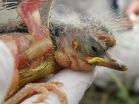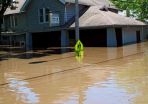(Press-News.org) More than half of all people are hosts to Candida albicans in their bodies. This species might be located on their skin or mucous membranes or in the intestines – frequently without causing any symptoms. However, it can be dangerous to patients whose immunological system has been weakened such as after organ transplants or chemotherapy with cancer. Then, this fungus penetrates into deeper layers of tissue and uses the blood system to spread throughout the body. In Germany alone, several thousand people die from systemic candida infections every year.
But why does Candida albicans become lethal to people? Which genes are active in the pathogenic state? Are there any interactions between the host and the fungus? What protective mechanisms might prevent the pathogenic state in humans? Researchers at the Fraunhofer Institute for Interfacial Engineering and Biotechnology (IGB) in Stuttgart, Germany, asked themselves these and other questions applying pioneering sequencing technology.
This technology is a real game-changer because it can be automated and it greatly accelerates the analysis of genotypes. A case in point is decoding a person's genome and determining the sequence of bases of DNA, which can now be done within a couple weeks. As a comparison, five large-scale research centers with 150 coworkers have been working at sequencing the human genome for seven years, and the Humane Genome Project cost approximately $3 billion. The sequence of the approximately 3 million bases of the human genome was made public in 2001.
Researchers at the Fraunhofer Institute for Interfacial Engineering and Biotechnology have been taking advantage of this cutting-edge sequencing technology to find out which genes play a role in causing the disease to break out with the fungus and the host. Researchers are working with system biology scenarios that they hope will help explain the essential pathogenic mechanisms. The researchers start off by isolating the mRNA, i.e., the copies of all of the active genes, from the human pathogenic yeasts. Then they transform the mRNA into DNA to subsequently fragment and sequence them. What's tricky with this Next-Generation sequencing is the fact that it is not just a couple of fragments that are sequenced, but millions of DNA fragments simultaneously. A single strand of DNA acts as a matrix and an enzyme resynthesizes the second DNA strand on it, one building block after another in a very tight space. To follow this process, each of the four different building blocks (the bases adenine A, guanine G, cytosine C or thymine T) is marked with a different fluorescent dye, and a detector captures all of the various light signals. This is how the sequence of bases can be read from each fragment. The stupendous quantities of data are then analyzed with bioinformational techniques, and researchers can directly discover which genes are still active.
Biologist Christian Grumaz of the Fraunhofer Institute for Interfacial Engineering and Biotechnology provides an explanation for this: "At top speed, we can use this Next-Generation DNA sequencer to simultaneously sequence as many as 100 million DNA fragments with a reading length of up to 500 bases." His institute colleague Dr. Kai Sohn adds, "For the first time, this method enables us to simultaneously obtain both highly sensitive transcription profiles from human pathogenic fungi and infected host cells." Researchers are hoping that this will enable them to draw key conclusions on why the fungus is so dangerous for certain persons with a weakened immunological system.
Scientists will be unveiling their findings at the joint Fraunhofer stand in Hall 9, Stand 30 while graphically demonstrating the huge amounts of data that Next-Generation sequencing supplies. Beyond this, 10 books show examples of the transcriptome of Candida. Other topics that will be discussed at their stand include clinical tests for diseases of the respiratory passages, in vitro testing systems, utilizing nature as a chemical factory, biochips for individualized breast cancer therapy, DNA microarrays for quick diagnosis of pathogens, and 3-D skin models.
INFORMATION:
Fraunhofer Group for Life Sciences
Fraunhofer Group for Life Sciences is an association of six Fraunhofer institutes with expertise in biology, medicine, pharmacology, toxicology, medical biotechnology and foodstuffs technology.
More information under:
www.lifesciences.fraunhofer.de
Tracking down pathogenic yeasts
2010-09-29
ELSE PRESS RELEASES FROM THIS DATE:
Understanding Missouri River's sediment dynamics key to protecting endangered species
2010-09-29
Sept. 28, 2010 -- A new report from the National Research Council says that more organized and systematic procedures for gathering and evaluating data on Missouri River sediment are required to improve decisions and better manage the river's ecosystem, including protecting endangered species and developing water quality standards. In addition, the report finds that the U.S. Army Corps of Engineers' projects to restore habitats along the Missouri River are not significantly changing the size of the oxygen-depleted "dead zone" in the Gulf of Mexico, nor will options for ...
Wheel in a corset
2010-09-29
Just imagine your car suddenly comes to a halt on a quiet country road, and it's only four years old. This is not a pleasant thought. A breakdown is expensive. Not to mention the safety risk to the occupants – because the breakdown was caused by the extremely light plastic wheels so highly praised by the car salesman. One of them has broken. »Such a scenario must, of course, never happen in reality,« states Prof. Dr.-Ing. Andreas Büter from the Fraunhofer Institute for Structural Durability and System Reliability LBF in Darmstadt. The experts there specialize in operational ...
Study finds potential climate change side effect: More parasites on South American birds
2010-09-29
A Wildlife Conservation Society (WCS) study on nesting birds in Argentina finds that increasing temperatures and rainfall—both side effects of climate change in some parts of the world—could be bad for birds of South America, but great for some of their parasites which thrive in warmer and wetter conditions.
The study, which looked at nesting forest birds in Santa Fe, Argentina, found that increases in temperature and precipitation produce a bumper crop of parasitic fly larvae of the species Philornis torquans, parasites that burrow into the skin of baby birds to feed. ...
Why we fight: Men check out in stressful situations
2010-09-29
A new study by USC researchers reveals that stressed men looking at angry faces had diminished activity in the brain regions responsible for understanding others' feelings.
Turns out the silent and stoic response to stress might be a guy thing after all.
"These are the first findings to indicate that sex differences in the effects of stress on social behavior extend to one of the most basic social transactions — processing someone else's facial expression," said Mara Mather, director of the Emotion and Cognition Lab at USC.
In an article appearing the October 6 issue ...
Assessment of US doctoral programs released, offers data on more than 5,000 programs nationwide
2010-09-29
Sept. 28, 2010 — The National Research Council today released its assessment of U.S. doctoral programs, which includes data on over 5,000 programs in 62 fields at 212 universities nationwide. The assessment is designed to help universities evaluate and improve the quality of their programs and to provide prospective students with information on the nation's doctoral programs. (See Full Report)
"This report and its large collection of quantitative data will become in our view an important and transparent instrument for strengthening doctoral education in the United States," ...
Pet allergies worsen hay fever symptoms, Queen's study finds
2010-09-29
Being allergic to dogs or cats may worsen your ragweed allergies, according to a study from Queen's University.
Researchers found that people with pet allergies often develop ragweed allergy symptoms more quickly than others. But the study also suggests that once allergy season is in full swing, those symptom differences subside.
The team, led by Anne Ellis, an assistant professor in the departments of medicine and microbiology & immunology, exposed 123 participants to ragweed, and noted that pet allergy sufferers reported symptoms differently than their non-animal ...
African-American seniors at twice the risk for mental abuse, 5 times for financial exploitation
2010-09-29
PITTSBURGH—In the first population-based survey to indicate a racial disparity in the psychological abuse of senior citizens, University of Pittsburgh researchers found that African American seniors could be twice as likely to be mistreated than elders of other races. The survey also revealed that African American elders could be up to five times more susceptible to being swindled. Reporting the survey results in The Gerontologist, the researchers urged that health care and social service workers be especially vigilant for the possible mistreatment of African American seniors.
Lead ...
Model aims to reduce disaster toll on city's social, economic fabric
2010-09-29
WEST LAFAYETTE, Ind. - Researchers have created a computer model that predicts how a disaster's impact on critical infrastructure would affect a city's social and economic fabric, a potential tool to help reduce the severity of impacts, manage the aftermath of catastrophe and fortify infrastructure against future disasters.
"The model works for any type of disaster that influences the infrastructure," said Makarand Hastak, head of construction engineering and management and a professor of civil engineering at Purdue University. "If we can identify in advance the most ...
John P. Holdren addresses climate change, stressing need for international cooperation
2010-09-29
In a recent keynote address before the Kavli Science Forum: 2010 in Oslo, Dr. John P. Holdren -- science advisor to U.S. President Barack Obama -- provided insight into why climate change is a priority to the Obama administration, and pressed the need for an international effort to mitigate, and adapt to, what he termed the effects of "global climate disruption."
"We cannot solve the great problems of our time alone - any of us - as individual nations," he stated. "We need to solve them together, and science and technology pursued together are going to be immensely important ...
International scientific forum on alcohol research
2010-09-29
In a very large cohort of African-American women in the US, the association between the consumption of alcohol, tea, and coffee and the development of type 2 diabetes mellitus (late onset diabetes) was studied for 12 years. Tea and decaffeinated coffee showed no relation with diabetes, but the regular moderate intake of both caffeinated coffee and alcohol appeared to reduce the risk of contracting late onset diabetes significantly.
This paper is particularly important because some previous studies have not shown a strong association between alcohol and the risk of ...


